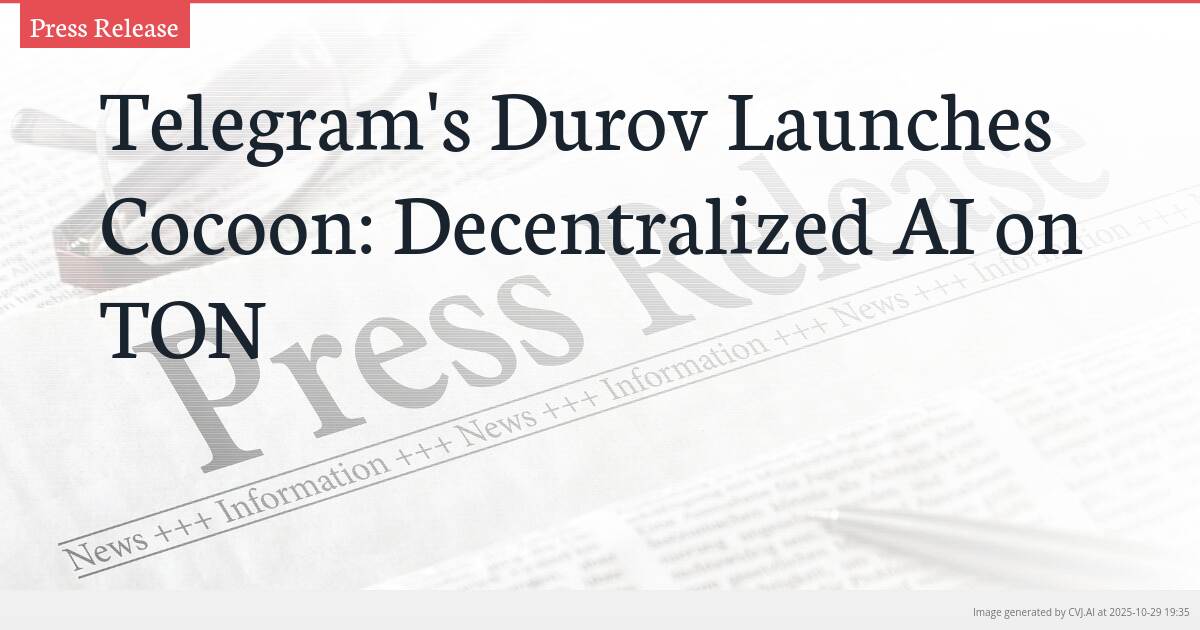This summary text is fully AI-generated and may therefore contain errors or be incomplete.
Introduction
Telegram co-founder Pavel Durov has launched Cocoon, a revolutionary decentralized AI network built on The Open Network blockchain that promises to deliver artificial intelligence capabilities while preserving user data privacy. Announced at the Blockchain Life 2025 forum in Abu Dhabi, the Confidential Compute Open Network represents a direct challenge to centralized AI providers by enabling users to contribute GPU processing power in exchange for Toncoin rewards while maintaining control over their personal data.
Key Points
- Built on TON blockchain to provide decentralized AI tools while maintaining user data privacy
- Users can contribute GPU processing power to the network and earn Toncoin rewards
- Announced at Blockchain Life 2025 forum as a response to concerns about centralized AI data control
The Cocoon Vision: Privacy-First AI Infrastructure
Pavel Durov’s announcement of the Confidential Compute Open Network, codenamed Cocoon, marks a significant milestone in the convergence of blockchain technology and artificial intelligence. The project aims to address growing concerns about data privacy in an increasingly AI-driven world by creating a decentralized alternative to centralized AI providers. Built atop The Open Network (TON) blockchain, Cocoon represents Durov’s vision for an AI ecosystem where users can access sophisticated AI tools without surrendering their personal data to corporate entities.
The timing of Cocoon’s announcement reflects mounting global apprehension about how major technology companies handle user data in their AI systems. Durov positioned the project as essential for preserving human freedom in the digital age, arguing that centralized control over AI creates inherent risks for user autonomy and privacy. By leveraging TON’s blockchain infrastructure, Cocoon ensures that data processing occurs in a trustless environment where users maintain sovereignty over their information throughout the AI interaction process.
Economic Model: GPU Power for Toncoin Rewards
Cocoon introduces an innovative economic model that incentivizes user participation while building the network’s computational capacity. Users can contribute processing power from their graphics processing units (GPUs) to the decentralized AI network and receive Toncoin, TON’s native cryptocurrency, as compensation. This approach creates a dual-sided marketplace where both AI consumers and computational resource providers benefit from the ecosystem’s growth.
The GPU mining mechanism represents a strategic departure from traditional AI infrastructure models that rely on centralized data centers owned by large corporations. By distributing computational requirements across a network of individual contributors, Cocoon not only enhances decentralization but also creates new economic opportunities for GPU owners. This model could potentially unlock significant unused computational capacity worldwide while providing participants with a tangible financial return through Toncoin rewards.
The integration with TON’s existing cryptocurrency ecosystem provides immediate utility for the earned tokens, as Toncoin already functions within Telegram’s broader ecosystem and various decentralized applications. This established economic foundation distinguishes Cocoon from many blockchain projects that must build their token economies from scratch, potentially accelerating adoption and network effects.
Strategic Implications for Telegram and TON Ecosystem
Cocoon’s development on The Open Network blockchain represents a strategic expansion of Telegram’s ecosystem beyond messaging into the rapidly growing AI sector. The announcement at the Blockchain Life 2025 forum in the United Arab Emirates underscores the global ambition of the project and positions TON as a leading platform for decentralized AI applications. This move aligns with Durov’s longstanding commitment to privacy and user empowerment that has characterized Telegram’s development philosophy.
The decentralized AI network could create significant synergies with Telegram’s existing user base of hundreds of millions worldwide. By integrating AI capabilities that respect user privacy, Telegram may differentiate itself from competitors while providing additional value to its community. The potential for seamless integration between Cocoon’s AI tools and Telegram’s communication platform presents compelling opportunities for future development and user adoption.
Durov’s emphasis on decentralized AI as crucial for human freedom reflects broader industry concerns about the concentration of AI power among a few technology giants. Cocoon positions itself as a foundational infrastructure for a new generation of AI applications that prioritize user control and data sovereignty. As regulatory scrutiny of big tech’s AI practices intensifies globally, Cocoon’s privacy-focused approach may gain significant traction among users and developers seeking alternatives to centralized AI services.
📎 Read the original article on cointelegraph.com

